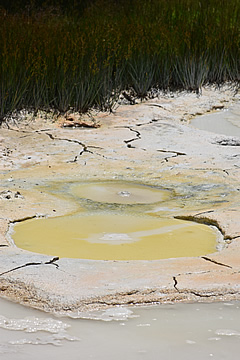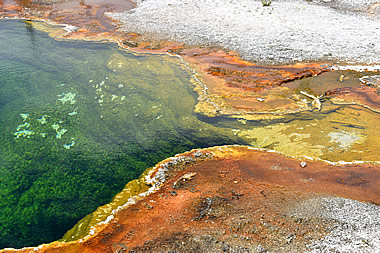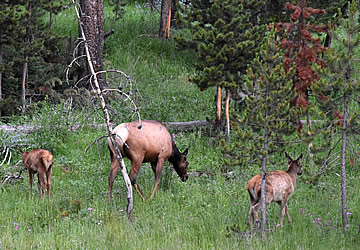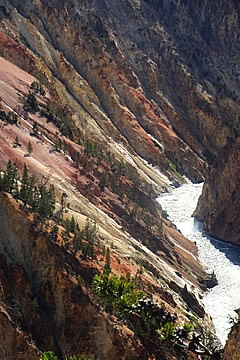


More wildly colourful landscapes and the magnificent Grand Canyon of the Yellowstone with waterfalls and dramatic rock walls.
See also SW Yellowstone & North Yellowstone

We were staying in Lake Lodge Cabins on the north side of Yellowstone Lake but arrived in the park early from Grand Teton NP so visited West Thumb Geyser Basin on the way. It's one of the lesser visited parts of Yellowstone National Park1 but it is a beautiful place, quite extensive, with brilliantly coloured pools. The vast majority of Yellowstone lies in the state of Wyoming, with a few percent in Montana and Idaho.




Situated on the west side of Yellowstone Lake, the bay of West Thumb was formed by a massive volcanic eruption 125,000-200,000 years ago and is significantly deeper than any other part of the lake.






The colours in and around thermal pools are usually formed by heat-loving organisms called thermophiles. These algae, bacteria and archaea have lived on the earth for almost four billion years.












Yellowstone formed as the result of three massive volcanic explosions - 2.1 million, 1.3 million and 640,000 years ago, this last creating the Yellowstone caldera, the bowl-shaped depression which forms after magma has been ejected from below the earth's surface by a volcanic eruption. The Yellowstone caldera covers roughly 50km by 70km.2
Around 80 smaller eruptions have occurred since then, one of these, around 174,000 years ago, created West Thumb of Yellowstone Lake. During and after these explosive eruptions huge lava flows of viscous rhyolitic lava and less voluminous basalt lava flows partially filled the caldera floor and surrounding terrain.



Lake Lodge has a nice big covered porch with a view of the lake, though it was undergoing renovation when we were there and half of it was cordoned off while it was dug up.


On the lake shore there is almost always a single bison, but we did see other bison here and also magnificent elk. The cabins at Lake Lodge are OK but the restaurant here is little more than a cafeteria-style place with dire looking food - we missed dinner one evening because the only other option, the hotel just up the road, was fully booked so we made sure to book for the next night, We had an excellent meal there and also a very good breakfast.




Between Yellowstone Lake and the Grand Canyon of the Yellowstone the road runs past Sulphur Cauldron. There was a single huge bison down there - another had crossed the road in front of us just as we got here!

Sulphur Caldron sits on the edge of one of the most active areas of Yellowstone's underground volcano. Sulphur-rich gasses rise up through the ground, and billions of thermoacidophiles thrive here, converting the hydrogen sulphide gas to sulphuric acid. Thermoacidophiles love a hot, acidic environment. Here they live in a pool almost as acidic as battery acid!





We almost didn't go to the Grand Canyon of the Yellowstone but were really glad we did - very impressive and beautiful scenery.
We stopped at Uncle Tom's Point on South Rim Drive for a view of the Upper Falls, 33m high, and at Artist Point at the end of the Drive for a great view of the Lower Falls, with a drop of 93m.
The canyon, 32 km long, is carved out to a depth of up to 300m by the Yellowstone River.3
The Lower Falls actually mark the start of the canyon where the river flows from rocks less resistant to erosion to a region of softer rock.




We then drove along the north rim stopping at a few of the viewpoints.




The canyon is particularly impressive at Lookout Point - lots of pinnacles and fins of rock leading down to the river. One of the pinnacles had an occupied Osprey nest on top.



Grand View lives up to its name: the colours on the slopes down to the river are gorgeous and there are a few steam vents to be seen too.
Final stop was at Inspiration Point, a detour off North Rim Drive. The section of the Yellowstone River here lies on a major fracture zone and annually there are thousands of minor tremors. The observation platform used to extend 100ft further into the canyon but a large earthquake with numerous after-shocks in June 1975 caused a section of the cliff to collapse.


The canyon is young, geologically-speaking, having been formed when Yellowstone's most recent ice cap melted 14,000 years ago and the river began to carve its way down through the rhyolitic lava flows. Volcanic heat and gases flowing through the rock transform it from sandy greys and pinks to rose and gold.
